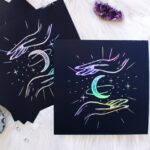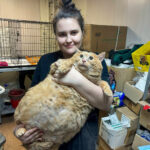Gray cats, often referred to as blue cats in feline fancy, hold a special allure for cat lovers worldwide. Their sleek, soft coats and captivating eyes make them stunning companions. While gray or blue hues appear across numerous breeds, we’re spotlighting some of the most distinguished gray cat breeds, with a special nod to the elegant Gray Shorthair Cat. Whether you’re already enchanted by gray felines or considering welcoming one into your life, delve into the fascinating world of these beautiful cats.
Breed Highlights: Gray Shorthair Cats and Their Kin
While “gray shorthair cat” isn’t a breed itself, it’s a descriptive term that brings to mind several breeds known for their gorgeous gray coats and shorter fur. Let’s explore some of these breeds, alongside other notable gray cat breeds, to understand the diversity within the gray feline family.
Russian Blue: The Plush Gray Shorthair
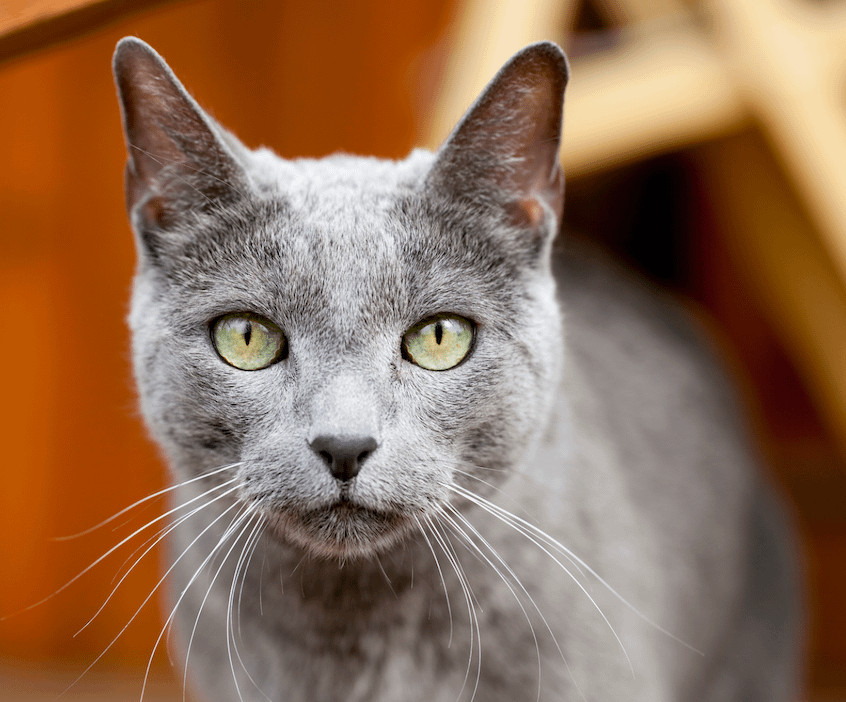 Russian Blue grey cat breed
Russian Blue grey cat breed
The Russian Blue is the quintessential gray shorthair cat, renowned for its striking appearance and refined demeanor. These cats are slender yet muscular, adorned with a luxurious double coat that’s dense, plush, and incredibly soft to the touch. This thick coat gives them a deceptively larger appearance. A hallmark of the breed is their eye color transformation: kittens start with yellow eyes that mature into a mesmerizing vivid green.
Russian Blues are known for their dual nature – playful and energetic, yet also reserved and sensitive. They often form a deep bond with one family member, sometimes showing hesitancy towards strangers and unfamiliar settings. Hygiene is paramount to these felines, especially concerning their litter box. A soiled litter box might deter them from use, highlighting the appeal of a self-cleaning litter box for Russian Blue owners. Interestingly, Russian Blues have a hearty appetite and can be prone to obesity if their food intake isn’t monitored.
Originating from Russia, as their name suggests, the Russian Blue’s dense, warm coat is a testament to their adaptation to colder climates. Historically, their plush fur was so prized that they were, according to legend, hunted for their resemblance to seal fur.
Korat: The Silver-Tipped Gray Shorthair of Thailand
 Korat cat
Korat cat
The Korat stands out as one of the oldest and most naturally pure breeds. This gray shorthair cat boasts a unique blue-gray coat with silver tips, creating a distinctive luminous sheen. Korats are born with striking blue eyes, which undergo a color journey, shifting to amber before settling into a brilliant green. They are medium-sized cats with a surprisingly muscular build.
Korats are highly social creatures, thriving on attention and interaction. They are affectionate and love to cuddle, play, and forge strong bonds with their families. While generally amicable with other pets, they can exhibit jealousy if they perceive another animal is receiving undue attention.
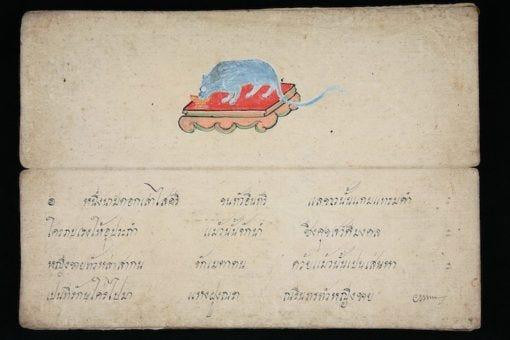 tamra maew, a Thai book of cat poems
tamra maew, a Thai book of cat poems
© Sam Sawet / Wikimedia Commons / CC-BY-SA-4.0
Hailing from Thailand, the Korat’s history is deeply intertwined with Thai culture. They first appeared in the tamra maew, a Thai book of cat poems dating back centuries. In Thailand, Korats are revered as symbols of prosperity, health, and good fortune, holding a cherished place in their traditions. Despite their cultural significance, they remain relatively uncommon in American homes.
Chartreux: The French Gray Shorthair Hunter
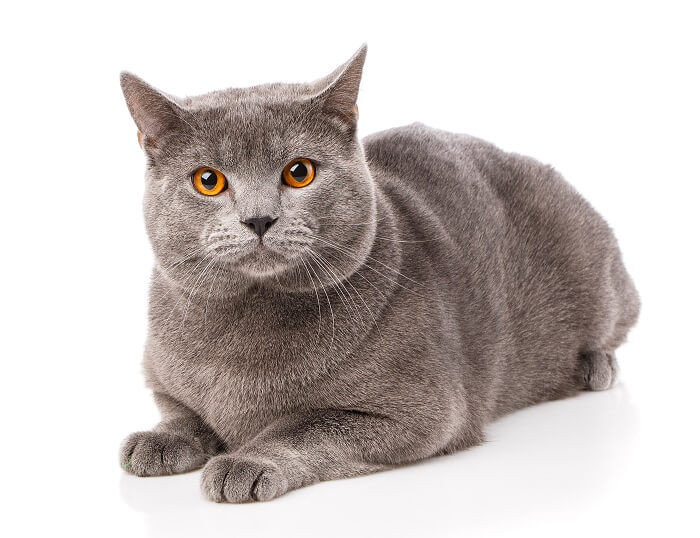 Chartreux cat
Chartreux cat
Chartreux cats are often endearingly described as “potatoes on toothpicks” due to their sturdy, robust bodies balanced on slender legs. This gray shorthair breed features a distinctive blue-gray coat that’s not only dense but also water-repellent, offering protection in various climates. Underneath their plush coat, they are well-muscled and agile, living up to their historical reputation as exceptional mousers, celebrated in French literature.
Beyond their hunting prowess, Chartreux cats are known for their gentle temperament, loyalty, and quiet nature. They are playful and enjoy interactive games, even showing a fondness for fetching. Remarkably, they can learn their names and respond when called, demonstrating their intelligence and trainability.
Legend suggests that the Chartreux breed was developed by Carthusian monks at the Grande Chartreuse monastery in the French Alps. It’s rumored they were selectively bred for their quiet voices to maintain the serene atmosphere of the monastery, though this remains an unverified, charming anecdote.
Nebelung: The Misty Gray Shorthair with a Longhaired Veil
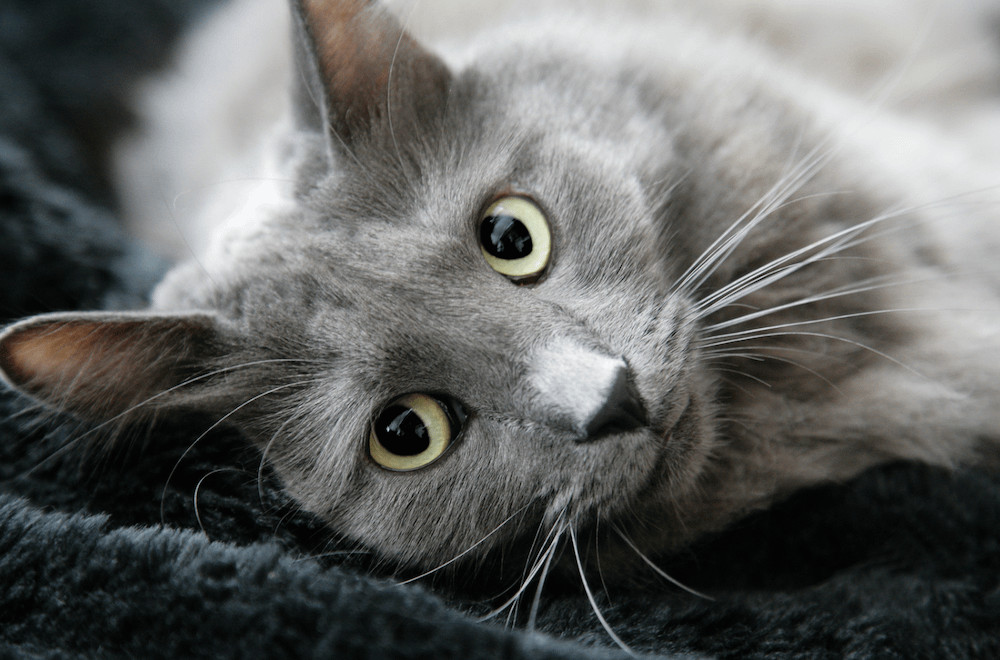 Nebelung cat
Nebelung cat
© Nebelung / Wikimedia Commons / CC-BY-SA-3.0
The Nebelung cat often draws comparisons to the Russian Blue, sharing the striking blue-gray coat and vivid green eyes. However, the Nebelung distinguishes itself with a semi-long coat, characterized by elegant, silver-tipped guard hairs that give their fur a misty, ethereal appearance. Beneath the longer fur, they possess the same graceful and muscular build as their shorthaired Russian Blue cousins.
Nebelungs are known for their mild and gentle personalities, often described as soft-spoken and sweet-natured. They are affectionate and enjoy playtime, making them wonderful companions. Loyal and devoted, they form strong bonds with their families without being overly demanding of attention. They tend to be reserved and shy around unfamiliar people.
Originating in America, the Nebelung breed has a more recent history. They emerged from a pairing between a black Domestic Shorthair and a Russian Blue, inheriting traits from both lineages. The breed name, Nebelung, meaning “creatures of the mist” in German, perfectly captures their unique, misty gray appearance.
British Shorthair: The Classic Gray Companion
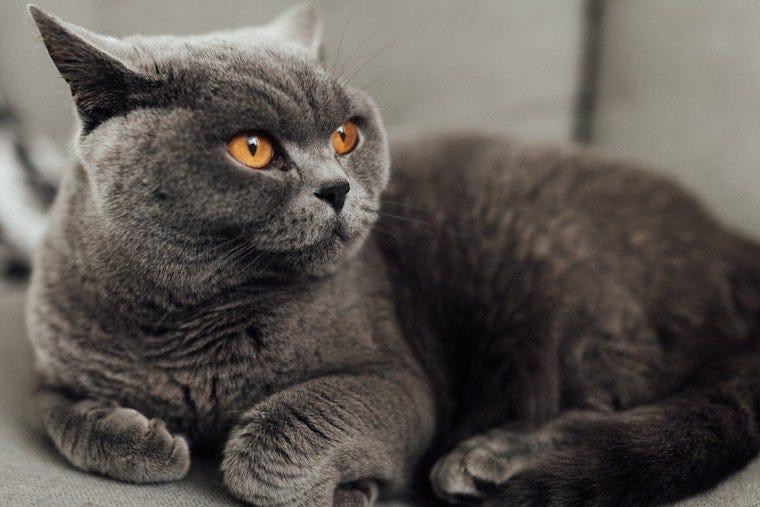 British Shorthair
British Shorthair
The British Shorthair, historically known as the British Blue, is a quintessential gray shorthair cat breed. They boast a dense, plush coat that’s both crisp to the touch and waterproof, providing excellent insulation. Their body is compact and cobby, supported by a sturdy frame. Medium to large in size, they have a distinctive massive, round head set upon a short, thick neck, sometimes earning them the nickname “bulldog of the feline world.” While famed for their blue-gray coat, British Shorthairs can also come in a variety of other colors and patterns.
British Shorthairs are known for their calm and even-tempered nature. While initially reserved, they warm up to people once comfortable and form deep attachments to their families. They are particularly well-suited to households with children, displaying remarkable patience, affection, and adaptability to changes in their environment.
Historically significant in the cat fancy, the British Shorthair is considered the first official show cat. Originating as common domestic cats in Britain, often called “moggies,” they evolved over time to be recognized for their distinct breed characteristics. By the late 19th century, they transitioned from working cats to cherished family companions, welcomed into homes for their warmth and companionship.
Persian: Gray in a Luxurious Long Coat
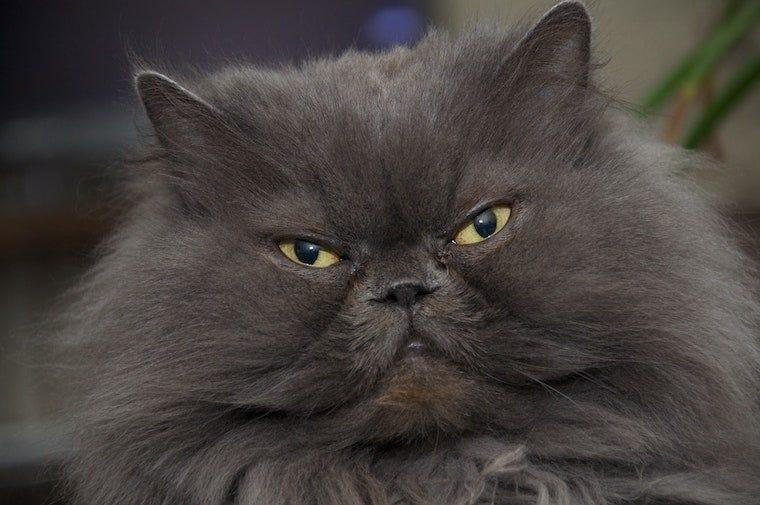 Blue Persian cat
Blue Persian cat
While Persian cats are most famous for their flowing white coats, the Blue Persian showcases the gray spectrum in all its glory within this breed. The Persian is an ancient breed, believed to be descended from Turkish Angora cats and other long-haired breeds from Persia, Afghanistan, Burma, China, and Russia. Their elegant appearance captivated an Italian nobleman in the 1600s, who brought them to Europe, where they later became favorites of Queen Victoria.
Persians are often described as “furniture with fur” due to their relaxed and sedentary nature. They possess a sweet, gentle disposition and thrive in tranquil environments. While they appreciate grooming and petting, they are generally less inclined towards active play or chasing toys. However, like all cats, Persians benefit from daily gentle playtime to maintain their well-being. It’s important to note that while Persians are not shorthair cats, the “Blue Persian” variety demonstrates the beauty of gray coloration in felines across different coat lengths.
Scottish Fold: The Charming Gray Folded-Ear Cat
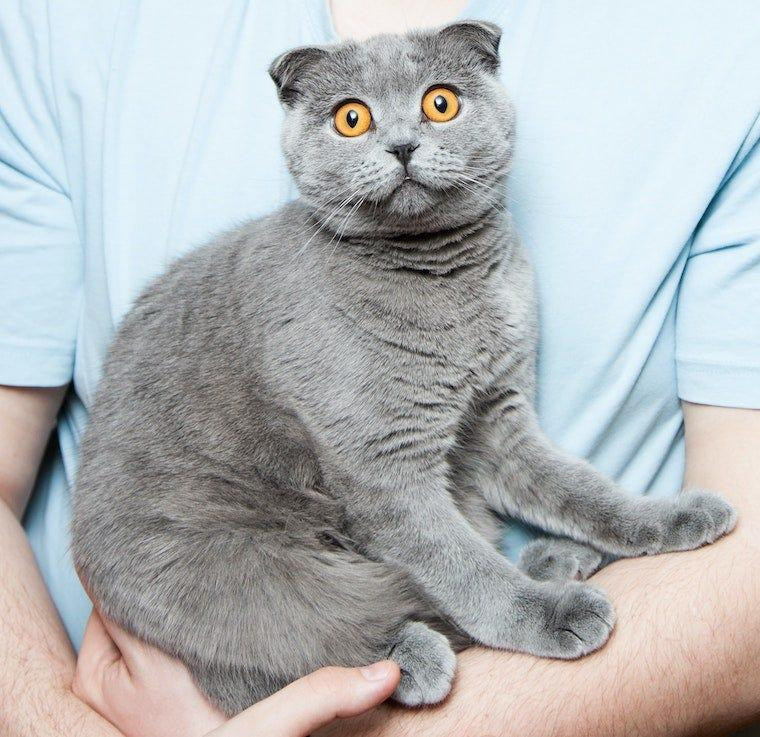 Scottish Fold cat in man
Scottish Fold cat in man
Scottish Folds are known for their distinctive folded ears and sweet, endearing personalities. Their plush, dense fur can be either short or long, and gray is a common and attractive color for this breed. They have a sturdy, well-padded body and a generally relaxed and agreeable temperament, making them popular family pets in America and Europe. The Scottish Fold is also known for its charming “Buddha sit,” where they sit upright with their legs extended.
Every Scottish Fold can trace its lineage back to Susie, a barn cat in Scotland discovered in 1961. Susie, a longhaired white cat with unique folded ears, became the foundation of the breed. Breeders crossed Susie with breeds like Persians, American Shorthairs, and Exotic Shorthairs to develop the Scottish Fold we know today.
An interesting fact about Scottish Folds is that all kittens are born with straight ears. The signature folded ears develop in about 50% of kittens, typically appearing between 18 to 24 days after birth. While not exclusively gray shorthair cats, many Scottish Folds exhibit the desirable gray coat color in both shorthair and longhair varieties.
Sphynx: Gray Skin in a Hairless Cat
 Sphynx cat
Sphynx cat
The Sphynx cat is instantly recognizable for its hairless appearance, although they may have a fine down covering their body. Many Sphynx cats have gray skin or a gray down, and despite their lack of fur, they require regular bathing to maintain skin health. Without weekly wiping or sponge baths, their skin can become sticky and prone to issues.
The Sphynx breed originated in Ontario, Canada, in 1966 when a hairless kitten named Prune was born to a black and white cat. Prune was bred in an attempt to create more hairless cats, and due to hairlessness being a recessive gene, some kittens were born hairless, and others with fur. Initially called Canadian Hairless Cats, they were later named Sphynx cats due to their resemblance to the ancient Egyptian Sphinx sculptures. Despite their somewhat stoic appearance, Sphynx cats are known for being highly social, affectionate, attention-seeking, and inquisitive. While not a traditional gray shorthair cat due to their lack of hair, the gray skin tone is a notable feature in many Sphynx.
Domestic Shorthair: Gray in Variety
 grey domestic shorthair cat with white chin outside
grey domestic shorthair cat with white chin outside
Domestic Shorthair cats, often called moggies, mutts, or mixed-breed cats, encompass any shorthair cat without a pedigree. They are the most common cat type in the United States, making up a significant majority of the cat population. Domestic Shorthairs exhibit incredible diversity in size, shape, coat patterns, and colors—including gray!
A gray Domestic Shorthair can present in numerous variations, such as solid gray, gray tabby (striped, spotted, or swirled patterns), gray colorpoint, or gray tuxedo (bi-color). This category highlights that the “gray shorthair cat” is not limited to specific breeds but can be found across a wide range of mixed-breed cats, showcasing the commonality and beauty of gray coats in the feline world.
Common Traits of Gray Cats
If you’re drawn to gray felines, you might have noticed a certain charm they often exude. While individual personalities vary across breeds and even within breeds, many gray cat breeds share some general characteristics.
Often, they are observed to have a calm, laid-back, and serene demeanor, beautifully balanced with a playful and curious nature. Many owners of gray cats describe them as intelligent and sociable, enjoying interaction and engagement with their human families.
However, don’t mistake their soft coats and gentle appearances for passivity. Gray cats can be quite charismatic and engaging when they choose to be. Some are known for being talkative, while others are more reserved in their vocalizations.
Be prepared for your gray cat to show a keen interest in your activities, whether you’re cooking in the kitchen or relaxing on the couch. Remember, these are general observations, and each cat is an individual with a unique personality.
Identifying Your Gray Cat’s Breed
Determining the breed of your gray cat can be an engaging and sometimes challenging puzzle. While coat color alone isn’t definitive, as gray appears in many breeds, certain physical traits and personality characteristics can offer valuable clues.
For example, a gray shorthair cat with a plush double coat, bright green eyes, and a preference for cleanliness might very well be a Russian Blue. If your gray cat has silver-tipped fur and an attention-seeking, social personality, a Korat could be the answer.
A robust body with slender legs, combined with a playful yet well-mannered disposition, could point towards a Chartreux. An affectionate and playful cat with semi-long fur and striking green eyes might be a Nebelung.
British Shorthairs, recognized by their crisp, dense coats, round heads, and thick necks, are another distinctive gray shorthair possibility. And of course, a hairless cat with gray skin requiring regular baths is likely a Sphynx.
If your gray cat displays tabby markings, colorpoint patterns, or a tuxedo coat, you may have a Domestic Shorthair, showcasing the vast diversity within this category.
Remember, breed identification can be a fun exploration, but ultimately, regardless of breed, your gray cat is sure to enrich your life with joy and companionship. Whether you share your home with a pedigreed Russian Blue or a charming Domestic Shorthair, the love of a gray cat is a uniquely rewarding experience.
Other Gray Cat Breeds to Admire
Gray coats are not limited to the breeds highlighted; they naturally occur in many other cat breeds, including:
 grey cat using Litter-Robot
grey cat using Litter-Robot
Considering adopting a gray cat breed? There’s perhaps nothing more delightful than watching your new feline companion enjoy the convenience of a self-cleaning litter box like Litter-Robot!
Whether you have a specific preference among gray cat breeds or simply appreciate their collective beauty, it’s undeniable that gray cats bring a unique elegance and spirit to the feline world.

